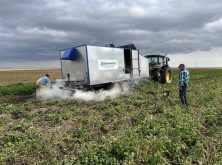John Berger and Spencer Hilton are southern Alberta farmers doing all they can as part of their crop and herbicide rotation programs to reduce the risk of weeds developing herbicide resistance.
Berger, who along with son Brad, crops about 5,000 acres near Nanton, south of Calgary, actually stockpiled some particularly effective chemistries when Monsanto sold a couple of its product lines, just to make sure they didn’t run out.
Hilton and his wife Lynne, and son Dane, along with his brother Sterling Hilton and his wife Lianna, crop around 12,000 acres east of Calgary. For several years they reluctantly used fall-applied herbicide products that didn’t really fit with their conservation farming objectives. But now in a new era for old products, lightly incorporated granular herbicides are a regular part of their routine.
Read Also

Claas brings 1000 Series SP forage harvesters to Canada
In mid-August, Claas unveiled its new line of Jaguar forage harvesters at an event in Visalia, California, deep in the heart of that state’s dairy region.
- Read more: Controlling cleavers without quinclorac
- Read more: Oats not affected by pre-harvest glyphosate
The objective for both these producers is to use a wide range of herbicide products, with different modes of action, to reduce the reliance on glyphosate and popular Group 1 and 2 herbicides. They aren’t shifting their focus to specific products, but rather using a wider range of herbicides as needed to avoid herbicide resistance. If, for example, reliance on one herbicide group can lead to resistance in 10 to 15 years, by using two, three or more different modes of action the risk is reduced exponentially. And hopefully in that wider window researchers may discover new modes of effective herbicides.
Neither farm family is dealing with herbicide resistance issues and they want to keep it that way. Berger says he may have one patch of herbicide resistance wild oats in a field near a roadway and he is intent to eliminate that. Hilton says he is not aware of any herbicide resistance weeds, but after recently buying more land or “if you rent land,” he can’t take anything for granted.
Important tools for these farmers in their bids to avoid herbicide resistance are older fall-applied chemistries now marketed by Gowan Canada that still have a fit. Both producers are committed to soil conservation and direct seeding farming practices, but a light harrow in the fall to ensure the granular products make soil contact still leaves plenty of cover on the field.
John Berger
Nanton Alta.
A few years ago when John Berger learned Monsanto was selling its long-time Avadex (Group 8) and Fortress (Groups 3 and 8) herbicide products he laid in a supply.

“We never really have stopped using them,” says Berger. “Quite often if we had a particularly bad patch of wild oats we would do a spot treatment with Avadex — apply it in the fall. And depending on how many wild oats were in the seed bank it was quite effective. So when we saw that Monsanto was discontinuing the products we stockpiled quite a bit of Avadex and Fortress, in particular, and just used them in special circumstances.”
Now that Gowan Canada has taken over the products, available in granular formulation, Berger says they use them more widely over the farm.
“We found over the years, particularly if you have a heavy infestation of wild oats, by the time you can use an in-crop treatment you’ve already lost yield,” he says. “So if we can use these products in the fall to knock weeds back before they start growing, we are preventing that early yield loss… and it is a different mode of action.”

Depending on weed pressure and crop rotation, Berger uses Avadex and Fortress mainly for wild oat control in cereals (although they can be used with all crops). He also uses Edge (Group 3 and a former Dow product) to deal with kochia. Edge has a good fit ahead of pulse and oilseed crops. And after recently learning that Treflan (a Group 3 former Dow product) is now available in Gowan’s new smaller MicroActiv granular formulation it may have a fit as well.
Berger applies the granular products in the fall using a Valmar spreader mounted on a heavy harrow. He uses a light harrow setting just to make sure the granules make soil contact. In spring he applies a glyphosate treatment pre-seeding and follows that with in-crop herbicide treatments as needed.
“Our main concern is to use different herbicides with multiple modes of action to reduce the risk of herbicide resistance,” he says. “And it also provides very effective weed control. We like to seed early in the spring which produces good results. This past year (2016) I say we had the Triple Crown with excellent quality, high yields and a decent price.”
Spencer Hilton
Strathmore, Alta.
As part of a pioneering soil conservation farm family in southern Alberta, Spencer Hilton says as they moved toward a minimum till, direct seeding system over the past 20 years at times he’s had almost a love/hate relationship with granular herbicides. He liked or loved that they were effective, but he didn’t like the tillage they required.
“Years ago when we were using a product like Edge it had to be incorporated three or four inches deep and it was recommended that we make multiple tillage passes to ensure it was incorporated,” says Hilton. “That really didn’t fit with soil conservation farming objectives.
“Tillage was an issue, and as the farm grew it also became another field operation, speed and efficiency became more important, handling granular product could be cumbersome, it was another cost, and generally it was a pain in the butt, so overall we felt it was much easier to just spray.”
Hilton says as pre-seeding glyphosate and other in-crop herbicide products entered the scene, he “begrudgingly” kept using the fall-applied granular products as needed. Even before it was recommended, he began to back off the degree of tillage.
“As we carried on with minimum tillage practices, conditions changed too,” says Hilton. “We used to incorporate products deeply to reach the weed seeds. But after years of direct seeding, now the seed bank of wild oats and green foxtail, for example, are really in the top inch of soil. So a shallower incorporation can get these products where they need to be.”
In more recent years, with products that now can work quite effectively with a very light soil incorporation, Hilton is definitely back into a “like mode” with fall-applied weed control products. They are effective for weed control, and help reduce the risk of herbicide resistance. Avadex and Fortress have the best fit in Hilton’s grain and oilseed cropping rotation — they are looking at bringing pulse crops back into rotation too.
“In our planning we pay attention to crop rotation, but we also pay a lot of attention to herbicide rotation, as well,” he says. “We start thinking about this in mid-summer. What products have we used this year or in the past couple years and now what should we be planning to use for the next cropping season ahead? We don’t want to apply more products, but different combinations of products with different modes of action, so we’re not having back to back to back years of the same chemistry.
“As we look at our herbicide rotation, if we’ve used a Group 1 or Group 2 product one year, then we look at using Avadex, which is a Group 8, or Fortress which is Groups 8 and 3. What is the best herbicide rotation for each field? I try to use as many groups as I can.” Hilton also keeps fungicide rotation in mind when treating crop diseases.
Hilton fall applies granular products, after mid-October, with a Valmar broadcast applicator mounted on a heavy harrow. Again, he wants just enough activity with the harrow tines to rattle herbicide granules through crop residue so they make contact with the soil surface.
In spring, he starts out with a pre-seeding burnoff product like glyphosate that may be tank mixed with something else for extra activity and that’s followed by in-crop herbicide treatments as needed.
“Using the granular herbicides probably is costing us a bit more in our overall crop protection program — it is another field operation and the products do cost,” he says. “But, I also think a proper herbicide rotation is our best defence against herbicide resistance. I guess it is a case of either we can pay now or pay later. But dealing with herbicide resistance can very expensive, especially when it starts to affect yield.”
Increased awareness in rotation
Brad Ewankiw, marketing manager for Gowan Canada says as more producers consider their herbicide rotations, the company has seen a significant increase in sales in the “older” chemistries found in Avadex, Fortress, Treflan and Edge.
With 2015 surveys showing Group 1 and 2 herbicide products are used on about 74 per cent of wheat acres and 61 per cent of barley acres, sales of some of their brand name products, with different modes of action, have more than doubled in the past three years. Gowan has been marketing Avadex and Fortress for about 10 years and about a year ago acquired Treflan and Edge. It’s the same chemistry as the original products, but some have been reformulated into a smaller MicoActiv clay granule, providing better soil coverage. Treflan this year will be available either as a liquid Treflan EC or as a MicroActiv granule.
Avadex stands as a leading product for wild oat control in cereals. Fortress has a good fit in front of canola providing control of a number of grassy weeds as well as some broadleaf weeds. Edge works well ahead of pulse and canola crops with strength in controlling a number of grasses as well as clevers and kochia. And depending on weed pressure, Treflan is a good base product providing suppression of wild oats and some broadleaf weeds, which later helps in-crop herbicides be more effective with control.
“More producers are looking for products that are not only effective, but offer different modes of action,” says Ewankiw. He also notes there is flexibility in applying the granular herbicides. Fall application probably has the best fit for workloads, but if harvest is delayed they can be spring applied, provided they are on two weeks before the crop is seeded.
“Feedback from across the industry shows farmers are becoming more aware of the need to act rather than re-act in terms of herbicide resistance,” he says. “Our message to producers, for the sake of a proper herbicide rotation, we don’t want people to overuse ours or any product. If possible use these Group 3 and 8 products once every four years. That way too, the cost can be amortized over the cycle of the crop rotation.”
















